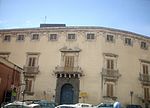Roman Catholic Diocese of Acireale
1844 establishments in ItalyAC with 0 elementsAccuracy disputes from January 2020All accuracy disputesReligious organizations established in 1844 ... and 2 more
Roman Catholic dioceses and prelatures established in the 19th centuryRoman Catholic dioceses in Sicily

The Italian Catholic diocese of Acireale (Latin: Dioecesis Iaciensis) is in Sicily. It has existed since 1844. It is a suffragan of the archdiocese of Catania.
Excerpt from the Wikipedia article Roman Catholic Diocese of Acireale (License: CC BY-SA 3.0, Authors, Images).Roman Catholic Diocese of Acireale
Piazza Giuseppe Garibaldi,
Geographical coordinates (GPS) Address Nearby Places Show on map
Geographical coordinates (GPS)
| Latitude | Longitude |
|---|---|
| N 37.6167 ° | E 15.1667 ° |
Address
Monumento ai Caduti
Piazza Giuseppe Garibaldi
95024
Sicily, Italy
Open on Google Maps








